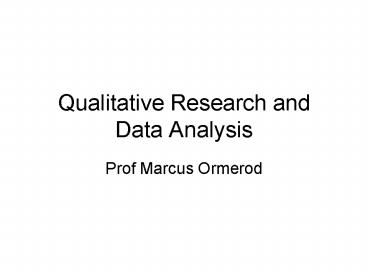Qualitative Research and Data Analysis - PowerPoint PPT Presentation
1 / 22
Title:
Qualitative Research and Data Analysis
Description:
Usually concerned with a deep understanding of 'real world' issues ... Bad studies have tarnished some methods. Analysis techniques can lack robustness ... – PowerPoint PPT presentation
Number of Views:42
Avg rating:3.0/5.0
Title: Qualitative Research and Data Analysis
1
Qualitative Research and Data Analysis
- Prof Marcus Ormerod
2
Qualitative Paradigms
- Usually concerned with a deep understanding of
real world issues - Hypothesis generating
- Insider researcher approach compatible
- Techniques can be developed as research unfolds
- Roots based in accepted scientific principles
- Emerged from Social Science research
- Still gaining credibility in some disciplines
- Criticised for its subjective nature
3
Qualitative Techniques
- Survey (can also be quantitative)
- Case Study
- Action Research
- Archival analysis
- Grounded theory
- Participation observation
- Naturalistic enquiry
4
Comments
- Bad studies have tarnished some methods
- Analysis techniques can lack robustness
- The study may not reveal what you were looking
for, but others things may emerge - Can lead to inductive logic breakthroughs
- Supports lateral thinking
- Uniqueness of study can prevent generalisation
5
Qualitative research
- Research questions rather than hypothesis
- Do the questions raised form a coherent set?
- Are there too many issues covered for one
research project? - Are they answerable - specific, measurable,
achievable - Connect questions to appropriate methods
6
- Will the right data flow from the methods chosen?
- What are the threats to validity?
- Do you need to triangulate your study?
- How much do you need to conform to the research
discipline you are in? - What is the sample from which the data will be
drawn?
7
Yin, R.K. (1994).
8
Case study
- Cases can be anything you want to focus on
- Cases studied in their context and comparison can
be made between them - Gives chance for in-depth study
- Can use a variety of techniques to collect data
- The timing of cases needs to fit
9
Archival/Documentary analysis
- Reviews existing documents and records
- Assumes you can get access to the records
- Assumes the documents are accurate reflection of
what happened - Weaker method if used on its own
10
Action Research
- The researcher is involved in the situation and
trying to resolve a problem, or implement a
change - More suitable to practitioners in the workplace
- Resolves practical problems
- Difficult for the novice researcher
- Needs the organisation to commit to the project
11
Ethnographic research
- Seeks to understand the life and customs of
people in a particular culture - Involves participant observation
- Needs careful ethical consideration
- A very flexible approach is needed
- Difficult for the novice researcher
12
Feminist/Emancipatory research
- Usually applied with research involving groups
that are marginalised by a society - Researching with, rather than on, a group
- Tendency towards qualitative data collection
13
Grounded theory approach
- Not suitable for novice researchers
- Researcher immerses themselves in area to be
studied in order to determine the research
questions that emerge - Requires careful coding and analysis of
qualitative data
14
Rigour in the research
- Credibility - comparable to internal validity
- Transferability - external validity
- Dependability - reliability
- Confirmability - is it objective
Robson, C. 1993 pp402-407
15
Yin, R.K. (1994) p33
16
Analysis
- Quasi-statistical - frequencies
- Patterns matrices, network maps, flow charts,
diagrams, rich pictures - Themes keywords and phrases, cross-cutting,
differences - Relationships people, activities, objects,
processes - Sequences order of events
17
Approach to analysis
- Data reduction
- Coding data
- Adding comments, reflections
18
Approach to analysis
- Data analysis and display
- Quasi-statistical - frequencies
- Patterns matrices, networks, maps, flow charts,
diagrams, rich pictures, - Themes keywords and phrases, compare and
contrast - Trends/Relationships people, activities,
objects, processes - Sequences order of events
19
Approach to analysis
- (Possible further data collection requirement
before moving to this next stage) - Conclusion drawing and verification
- Synthesis of analysis into a small set of
generalisations that cover the data - Linking generalisations to literature
20
(No Transcript)
21
(No Transcript)
22
Coding using computers
- Word
- Access
- Excel
- NVivo (specialist software package)































